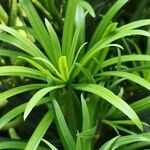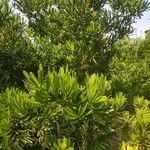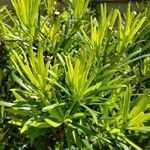Trees to 20 m tall; trunk to 60 cm d.b.h.; bark gray or grayish brown, peeling off in thin flakes; branches spreading or erect-spreading, rather dense; branchlets glabrous or pubescent. Leaves spirally arranged, sessile; blade dark green and glossy adaxially, grayish green, pale green, or tinged white abaxially, linear-lanceolate, oblanceolate, or oblong-oblanceolate, slightly curved, 1.7-12 cm × 2-10 mm, midvein prominently raised adaxially, slightly raised abaxially, base cuneate, apex mucronate or acute to long acuminate. Pollen cones axillary, usually in clusters of 3-5 on very short peduncle, spikelike, 3-5 cm, with several triangular bracts at base. Seed-bearing structures axillary, solitary, pedunculate, with few basal bracts. Receptacle red or purplish red when ripe, columnar. Epimatium purplish black when ripe, with white powder. Seed ovoid, ca. 1 cm in diam., apex rounded. Pollination Apr-May, seed maturity Aug-Sep. 2n = 38.
More
A tree. It grows to 20 m tall. The trunk is 60 cm across. The bark is greyish brown and peels off in large flakes. The branches are erect and spreading. The leaves are arranged in spirals and without leaf stalks. The leaves are dark green on top and pale green underneath. They are 1.7-12 cm long by 2-10 mm wide. The leaves are leathery. The pollen cones are in the axils of leaves and often in groups of 3-5. They are spike like and 3-5 cm long. The seeds are oval and about 1 cm across. The seeds are on a swollen receptacle which becomes red and fleshy.
It is a temperate to subtropical plant. It is native to S China and Japan. It grows in forests and open thickets from sea level to 1000 m altitude in S China. It can tolerate sea winds and salt spray. It suits hardiness zones 7-11. Arboretum Tasmania. Hobart Botanical Gardens. Melbourne Botanical Gardens.
More
Mountain of central and southern Japan. Forests, open thickets and roadsides; at elevations from near sea level to 1,000 metres.




